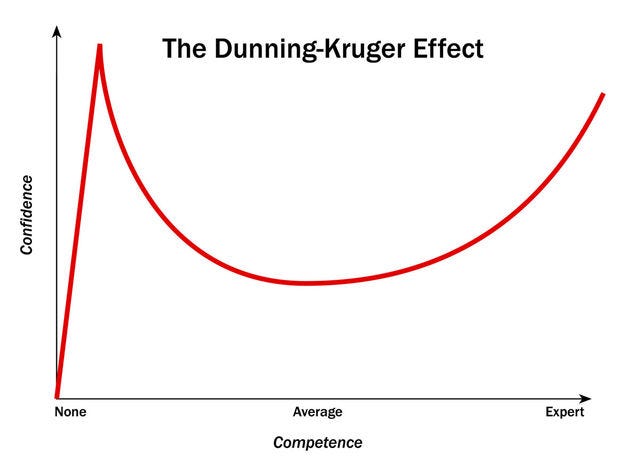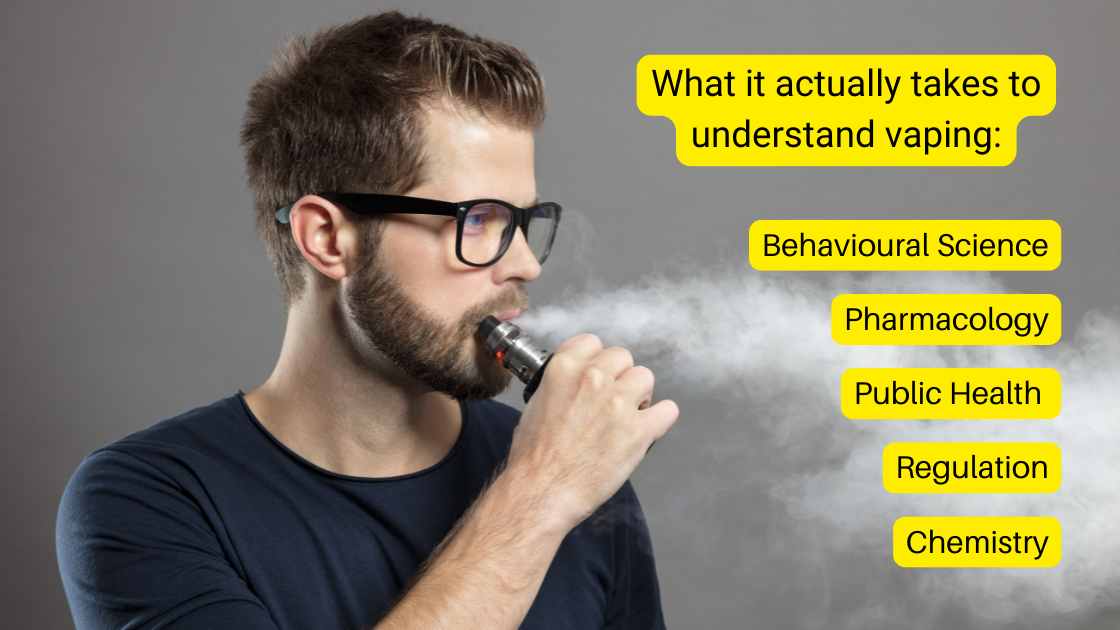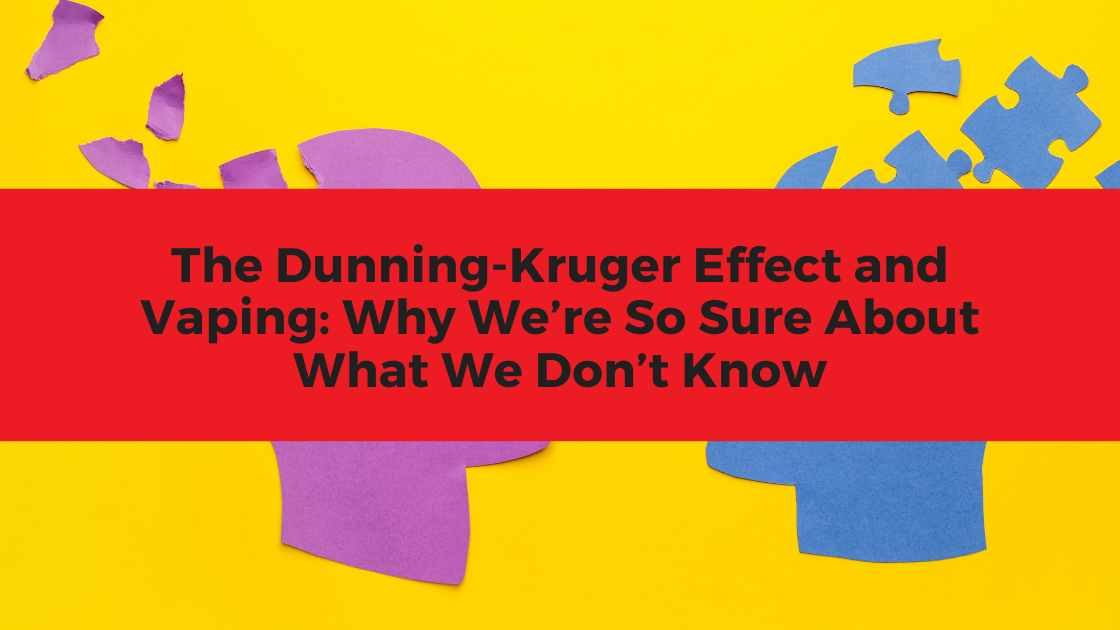The Dunning-Kruger Effect and Vaping: Why We’re So Sure About What We Don’t Know
We have all encountered them: the couch potatoes who insist that running is bad for their knees after watching a news segment on athletes with chronic knee injuries, or the cigarette smokers that dismiss vaping as a cessation tool because they’ve heard it’s just as harmful.
We may have even been these people at times, making bold, definite statements about things that we may not know that much about. So, what gives us this type of unwavering confidence? Are we just arrogant?
Believe it or not, there is a name for this confidence, and it’s called The Dunning-Kruger effect.
What Is the Dunning-Kruger Effect?
When we don’t know much, but we think we do, we are operating under the influence of what psychologists’ call “The Dunning-Kruger effect.”
The Dunning-Kruger effect is a type of cognitive bias, or way of thinking that can cause us to make wrong conclusions due to the overestimation of our competencies and capabilities.
Simply put, it occurs when we mistakenly assess our ability as much higher than it is therefore, we are unable to properly self-assess ourselves.
Origins of the Dunning-Kruger Effect
Psychologists David Dunning and Justin Kruger, observed this cognitive bias over the course of 4 studies in 1999 naming it the Dunning-Kruger Effect. In each study, they assessed individuals in different areas that required knowledge, wisdom, and savvy. Once the participants had done their assessments, they were then asked to assess themselves on how they felt they scored. It was discovered that those with the lowest aptitude had assessed themselves higher than their peers.
The Paradox: Overconfidence in the Incompetent
Dunning and Kruger noted that uninformed individuals will greatly overestimate their abilities whereas paradoxically someone with adequate experience in the same field will underestimate their knowledge. Confidence starts high with limited knowledge, dips as one learns more, and then increases again as expertise develops, creating a “confidence curve.”
A Real-World Example of the Confidence Curve
In the beginning, we met a cigarette smoker who never attempted vaping as a cigarette cessation tool because the internet says, “it’s just as bad.”
One day, a friend brings that smoker into a vape shop and describes how he quit smoking cigarettes by gradually reducing the percentage of nicotine in the e-liquid in a well-planned quit regimen. Our smoker didn’t know that this was something that could be controlled in a vape device and if planned, he could gradually wean off nicotine altogether.
The graph below illustrates the confidence curve of the Dunning-Kruger effect. We can use this to see how the cigarette smoker journeyed through the curve to reach a point of true understanding.

Our cigarette smoker was overly confident stating that vaping was just as bad as smoking until he realized there was a gap in his knowledge; so his confidence dropped when he realized it was more complex.
Once the smoker learned more about vaping science, he became confident that he was educated properly enough to recognize the pros and cons.
His assumed knowledge gave him inflated confidence, his confidence dipped once he realized vaping was more complex and finally, he became more confident speaking to experts with proper information.
The Vaping Knowledge Landscape
Vaping is susceptible to this type of biased thinking since most people don’t have a basic understanding of the science involved in vape research or even the components of what goes into vape creation or regulation. Most smokers in the UK (57% according to latest study) just understand that it is in the realm of smoking and perceive it as harmful. [1]
Understanding the Complexity Behind Vaping
To fully understand whether vaping is safe, we need to understand a lot of highly technical information such as the chemical compositions in e-liquids, toxicology, epidemiology, as well as the behavioral science regarding users and their habits. There are many complex scientific concepts necessary to properly evaluate a claim against the benefits or harm of vaping.

Dunning-Kruger in Action: Common Vaping Misconceptions
Common vaping misconceptions include Bronchiolitis obliterans, or more commonly called, popcorn lung. Bronchiolitis obliterans was coined popcorn lung due to its origin of being discovered in workers at a microwave popcorn factory. Workers had been exposed to a flavoring chemical in the factory called diacetyl. Over time this condition has become falsely associated with vaping because vape liquids and e-cigarettes can contain diacetyl, but manufacturers have begun minimizing its use. In the UK, it is already an official regulation that no diacetyl can be used in manufacturing.
Another common misconception is that vaping is “completely safe” which is not accurate either. Vaping is not completely without its risks. Although studies have found it typically has fewer toxic substances than cigarettes, when we vape, we inhale an aerosol that isn’t just water vapour.
By speaking in absolutes, we leave out any room for the nuances that come into play with this newer and evolving habit.
While social media-taught “experts” are spouting the absolute pros or cons of vaping, statements from experts in the field use a more appropriate level of uncertainty in their language.
Social Media and the Amplification of False Confidence
We have seen an uptick in the circulation of general misinformation as more social media platforms have developed [2]. Why would social media cause this effect on the spread of information? Social media is often emotionally driven and spreads faster and further for that reason. Online we often think because someone is confident in what they are saying that they must know what they are talking about so social media “experts” emerge and information can permeate before being fact-checked.
How Algorithms Promote False Certainty
Social media also uses algorithms. Social media algorithms are a tool that prioritizes engagement and virality. Not only can algorithms prioritize incorrect things by making false claims go viral, but they can also confirm already existing biases by continuing to show the user things along the same lines.
When using social media, it is best to keep in mind that there may be more opinion than fact. How can we ensure we won’t fall victim to an overconfident algorithm falsity?
Recognising the Signs in Ourselves and Others
To prevent yourself from becoming a victim of the Dunning-Kruger effect with vaping, or any other topic, start by asking yourself the following questions:
1. What do you know about vaping? Or what don’t you know?
2. How was that information obtained?
3. Would you consider those sources reliable?
Be mindful of those who speak in absolutes like “vaping is just as bad as smoking” A statement like that does not allow for nuance and it implies certainty.
Experts and researchers rarely speak in absolutes; they express caution when stating findings because they understand the complexity of science and recognize the importance of evidence-based claims.
Assess your knowledge, check your sources and don’t be afraid to be unsure of something!
Bridging the Knowledge-Confidence Gap
There is value in knowing what you don’t know. Self-assessment is a useful tool in life and provides a baseline for furthering your education and can help prevent overconfidence with false knowledge. The same is true when trying to learn the benefits and risks with vaping.
Gain confidence in your knowledge by accessing resources that provide information on both sides of the debate and use fact checked data as much as possible.
Wouldn’t it be nice if there was a tool to help you sift through the articles and find out faster what is factual? There is!
How Vaping Misinformation Detector Helps Combat the Dunning-Kruger Effect
The Vaping Misinformation Detector (‘VMD’) tackles the Dunning-Kruger effect by analysing vaping claims in articles and forming complex evaluations instantly. The app counters misinformation with rebuttals, and useful links to scientific research. By exposing users to critique and balanced evidence, VMD helps bridge the gap between overconfidence and informed understanding, raising awareness of the relative harm of vaping to smoking.
References
1. https://jamanetwork.com/journals/jamanetworkopen/fullarticle/2815561?utm_source=For_The_Media&utm_medium=referral&utm_campaign=ftm_links&utm_term=022824
2..Mapping the terrain of social media misinformation: A scientometric exploration of global research – ScienceDirect
Image credit: https://michaelgearon.medium.com/cognitive-biases-dunning-kruger-effect-ea1419038eb6
Guest article “The Dunning-Kruger Effect and Vaping: Why We’re So Sure About What We Don’t Know” by Laura Schmieder



Comments are closed here.